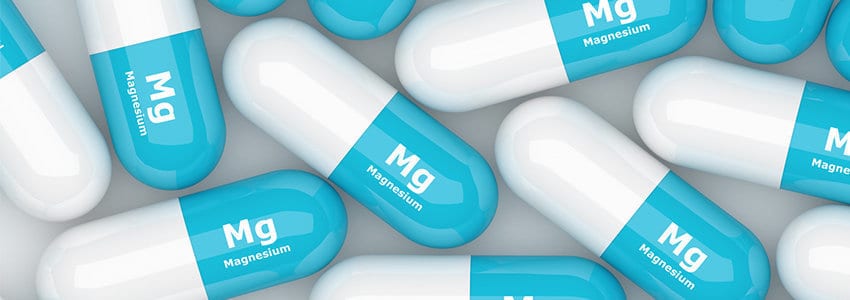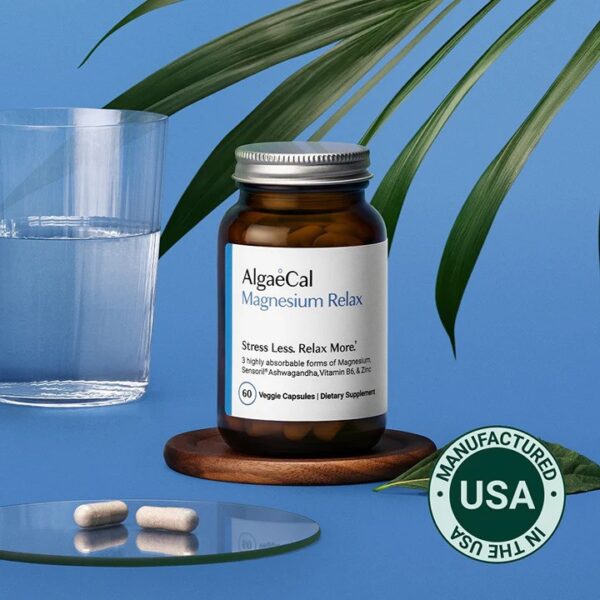It’s true that magnesium oxide is less soluble than several other forms of supplemental magnesium.
However, magnesium oxide is at least as effective (if not better) at restoring and maintaining a healthy level of magnesium in your cells and bones.
How is this possible? I’ll explain!
But before I do, we need to understand how magnesium is absorbed.
In all its natural forms, magnesium is bound to another chemical compound, for example: carbonate; gluconate; citrate; lactate; aspartate; or oxide. The combinations of magnesium and one of these compounds are called magnesium salts.
When you consume any magnesium salt, the magnesium must be freed from its partner compound during digestion and made soluble (ionized). Once it is made soluble, your body can absorb the magnesium.
For this to happen effectively, stomach acid has to be present. So it’s also helpful to remember that:
- It’s best to take your supplements with a meal because your stomach responds to your consumption of food by secreting stomach acid.
- Medications that prevent stomach acid production impair your ability to digest and absorb minerals – and virtually all other nutrients.
Why Magnesium Oxide Provides More Elemental Magnesium
It’s true that magnesium oxide is not as easy to render soluble as some other magnesium salts. It’s therefore not absorbed as rapidly as other forms of magnesium, e.g. magnesium citrate, gluconate, lactate, aspartate.
But although magnesium oxide has a lower rate of absorption it contains a MUCH greater amount of actual magnesium to begin with. More than what is provided by other magnesium salts.
Therefore, even with the lower rate of absorption, magnesium oxide still delivers more magnesium per tablet. So more magnesium gets into your bloodstream to deliver all its many benefits to your bones and body!
This is illustrated in the table Comparison of Magnesium Salts below: 1-2
| Comparison of Magnesium Salts | |||
| MG Salt | % Elemental MG | % Elemental MG Absorbed | Mg’s of Elemental MG Absorbed per 100 mg of MG Salt |
| Oxide | 60% | 23%* | 13.8 |
| Carbonate | 28% | ~20% ** | ~5.2 |
| Chloride | 26% | 20% | 5.2 |
| L-lactate | 12% | 42% | 5 |
| Citrate | 11% | 30% | 3.3 |
| Aspartate | 8% | 42% | 3.3 |
| Glycinate | 14% | 23% | 3.2 |
| Gluconate | 6% | 19% | 1.14 |
*On the web, you’ll see many sites claiming that only 4% of the magnesium in magnesium oxide is absorbed. This claim is based upon a small study by Firoz et al. (2001), which is discussed fully below. The actual data in this study shows something very different. The stated percentage of elemental magnesium absorbed from magnesium oxide in the above table — 23% — is the statistic provided in a review and meta-analysis of numerous studies by Ranade et al., (2001), cited below.
**Magnesium carbonate is nearly insoluble, but in the presence of stomach acid (HCl), magnesium carbonate is converted into magnesium chloride, which allows 20% of elemental magnesium to be absorbed.
As you can see, magnesium oxide contains the most elemental magnesium of 60%. And 23% of this can be absorbed.
Magnesium citrate, for example, contains only 11% elemental magnesium. And only 30% of this is absorbed.
So the percentage of elemental magnesium to begin with is just as important as the rate of absorption.
What Does This Mean For You, In Practical Terms?
You can get comparable or better health benefits with magnesium oxide. And you’ll also require fewer capsules, which will save you time and money.
The research most often cited to disparage magnesium oxide is a small study by Firoz et al. of 16 volunteers. The aim of this study was to test the claim that organic (chelated) magnesium salts (e.g., aspartate, lactate) are more easily absorbed than non-organic salts (e.g., oxide, chloride).3
The 16 volunteers were given four commercially-available magnesium salts: 2 organic (aspartate, lactate) and 2 non-organic (oxide, chloride), after which the amount of magnesium in their urine was checked. More magnesium excreted in the urine is thought to indicate that more magnesium has been absorbed; less magnesium excreted is thought to indicate that less magnesium has been absorbed. This rationale is based on the principle that the body works hard to maintain a steady state of magnesium balance, and in a steady state of magnesium balance, any extra magnesium absorbed will be excreted in the urine.
In this study, those taking magnesium oxide excreted less magnesium on average. So magnesium oxide was said to have a low fractional absorption rate of 4%. However, there are 2 important points not shared in this study:
- Half of the volunteers in this study excreted more or very comparable amounts of magnesium when taking magnesium oxide as they did when taking the other magnesium salts. Take a look for yourself at the table below – Urinary Magnesium, mg/day. The data in the following table is taken directly from Firoz M, et al’s 2001 article in Magnesium Research.
Averaging out the data produces a result that does not reflect what actually happened in the participants. Yet, what was reported is repeatedly cited on the internet. This is why I always read the full paper of any study I am going to rely upon for information.
2. Most importantly, the key practical discovery made in this study was: “Magnesium excretion increased with all magnesium supplements.” What this means is that all the magnesium salts tested, including magnesium oxide, delivered more magnesium than was needed to meet the body’s magnesium balance requirement.
| Urinary Magnesium, mg/day | ||||||
| Study participant | MG oxide | MG chloride | MG aspartate | MG lactate | Control 1* | Control 2* |
| A | 100 | 156 | 95 | 114 | 77 | 70 |
| B | 95 | 43 | 78 | 65 | 68 | 43 |
| C | 101 | 89 | 103 | 137 | 75 | 32 |
| D | 66 | 120 | 137 | 161 | 100 | 103 |
| E | 78 | 166 | 101 | 119 | 134 | 65 |
| F | 63 | 144 | 88 | 48 | 56 | 67 |
| G | 84 | 78 | 76 | 67 | 74 | 61 |
| H | 142 | 182 | 214 | 198 | 128 | 129 |
| I | 78 | 39 | 55 | 62 | 102 | 60 |
| J | 114 | 112 | 110 | 76 | 53 | 86 |
| K | 77 | 106 | 177 | 116 | 80 | 32 |
| L | 114 | 94 | 137 | 117 | 109 | 92 |
| M | 66 | 87 | 51 | 81 | 104 | 115 |
| N | 82 | 82 | 82 | 163 | 76 | 85 |
| O | 162 | 133 | 85 | 106 | 75 | 75 |
| p | 34 | 120 | 58 | 87 | 28 | 57 |
*Controls did not receive any supplemental magnesium.
Magnesium Oxide is Effectively Absorbed
Despite what you may have read on various websites, the peer-reviewed research on PubMed shows that magnesium oxide is effectively absorbed:
In a study involving 18 men, 24 hours after consumption of magnesium oxide supplements, magnesium levels in the urine increased about two times the normal amount. And, after 48 hours, magnesium levels had increased to roughly four times normal. The conclusion drawn by the researchers: these results clearly show that “magnesium oxide is effectively absorbed and elevates the biologically-active levels of magnesium in the bloodstream.” 4
It’s important to note here that magnesium oxide did not increase urinary excretion of magnesium within a couple of hours. This is an important point which I’ll explain below in “Higher bioavailability does not translate to more effective delivery to tissues.”
All forms of magnesium salts used in animal studies have been found to effectively restore magnesium levels in magnesium-depleted animals.
In one such study in 2005, rats were first given a magnesium-depleted diet and then provided with the same diet supplemented with 10 different magnesium salts: magnesium oxide, chloride, sulfate, carbonate, acetate, picolate, citrate, gluconate, lactate or aspartate. The results showed that while magnesium absorption values varied from 50% to 67%, all the magnesium salts used were equally efficient in restoring magnesium levels.5
The researchers also noted that “the quantity of magnesium in the digestive tract is the major factor controlling the amount of magnesium absorbed.” And as you now know, magnesium oxide contains a far greater amount of elemental magnesium than any of the other magnesium salts .5
A more recent animal study confirmed and strengthened these findings. In this one, for 5 weeks, rats were fed one of eight test diets supplemented with phytic acid (5 g/kg diet) and magnesium (155 mg elemental Mg/kg diet) from the following magnesium salts: magnesium oxide; magnesium sulfate; magnesium chloride; magnesium citrate; magnesium gluconate; magnesium orotate; and magnesium malate or EDTA magnesium salt.
The addition of phytic acid to the animals’ diet is important because phytic acid binds strongly to minerals and forms an insoluble complex. This means less of the minerals consumed can be absorbed. Despite the addition of phytic acid to the animals’ diet, all the magnesium salts tested were found to be comparably bioavailable: “The results indicate that any differences in the magnesium bioavailability of the compounds were small and physiologically irrelevant.” 6

Higher Bioavailability Does Not Necessarily Translate to More Effective Delivery to Tissues
When a magnesium supplement is highly bioavailable, it will be rapidly absorbed from the small intestine into the bloodstream, and magnesium blood levels will quickly rise. This sounds good, but when blood magnesium levels exceed a critical threshold, the excess is rapidly excreted by the kidneys. The end result is a shorter duration of magnesium availability to tissues. Magnesium salts with the greatest water solubility, bioavailability and rate of absorption are also more rapidly excreted in urine.
The lower parts of the small intestine are the primary sites of magnesium absorption. However, magnesium is also absorbed throughout the entire intestinal tract. Magnesium does not have special carriers that pull it into the bloodstream. Its absorption is a passive transcellular process.
For this kind of absorption process, the quantity of magnesium that passes through the digestive tract is the major factor controlling the amount of magnesium that is absorbed.
Because magnesium oxide contains more elemental magnesium and is less soluble, it’s absorbed into the bloodstream more slowly as it passes through the digestive tract. It will not raise blood levels excessively, and will therefore not be rapidly excreted. 5,7.8
The Research-Backed Bottom Line on Magnesium Oxide
You can get the same benefits from magnesium oxide with fewer pills. Magnesium oxide is the most effective magnesium supplement – and that is why it was selected for use in AlgaeCal Plus.
AlgaeCal Magnesium Relax™
Magnesium Relax provides a precise mix of these sleep-supporting nutrients to help settle the mind, reduce stress signals, and help you drift into deep, rejuvenating rest.
Here’s what goes into every bottle:
- Magnesium Glycinate, Citrate & Malate – a trio of easy-to-absorb magnesium forms that relax the body and mind so you fall asleep faster and stay asleep longer.
- Sensoril® Ashwagandha – supported by clinical research to cut cortisol by 24% and ease inflammation by 36%, clear signs your stress response is settling and true relaxation can begin.
- Zinc – supports melatonin production and helps you stay asleep through the night.
- P5P (active B6) – the bioavailable B6 that supports GABA production, helping quiet the mind and prepare the body for deep, restorative rest.
- AlgaeCal Absorb™ – our custom blend that helps your body soak up every drop of these calm-supporting nutrients.
Together, these ingredients help you relax more, stress less, and fall asleep naturally.
Get Magnesium Relax today for as little as $19 a bottle when you choose a 6-month bundle.
*These statements have not been evaluated by the Food and Drug Administration. This product is not intended to diagnose, treat, cure, or prevent any disease.
‡Results consistent with Clinical Trials. Results may vary.
†Open to US customers only.
FAQs
What is the best form of magnesium to take?
Magnesium oxide is at least as effective (if not better) at restoring and maintaining a healthy magnesium level in your cells and bones. Although magnesium oxide has a lower absorption rate, it contains much more elemental magnesium than other magnesium salts.
Should I take magnesium in the morning or at night?
Many people take magnesium at night because it can help them relax and sleep better. However, it does not cause drowsiness if taken during the day.
How do you know if you are magnesium deficient?
Some signs of magnesium deficiency include muscle spasms or cramps, loss of appetite, fatigue, weakness, abnormal heart rhythms, and pins and needles.
Will magnesium oxide help you sleep?
Any form of magnesium can help with sleep, but research shows magnesium glycinate may be most effective for enhancing quality sleep.
References
- Molecular weights: https://pubchem.ncbi.nlm.nih.gov/compound/6850729 For the other magnesium salts, use the search box in the top right corner of the page.
- Ranade VV, Somberg JC. Bioavailability and pharmacokinetics of magnesium after administration of magnesium salts to humans. Am J Ther. 2001 Sep-Oct;8(5):345-57. PMID: 11550076
- Firoz M, Graber M. Bioavailability of US commercial magnesium preparations. Magnes Res. 2001 Dec;14(4):257-62. PMID: 11794633
- Altura BT, Wilimzig C, Trnovec T, et al. Comparative effects of a Mg-enriched diet and different orally administered magnesium oxide preparations on ionized Mg, Mg metabolism and electrolytes in serum of human volunteers. J Am Coll Nutr. 1994 Oct;13(5):447-54. PMID: 7836622
- Coudray C, Rambeau M, Feillet-Coudray C, et al. Study of magnesium bioavailability from ten organic and inorganic Mg salts in Mg-depleted rats using a stable isotope approach. Magnes Res. 2005 Dec;18(4):215-23. PMID: 16548135
- Bertinato J, Plouffe LJ, Lavergne C, et al. Bioavailability of magnesium from inorganic and organic compounds is similar in rats fed a high phytic acid diet. Magnes Res. 2014 Oct-Dec;27(4):175-85. doi: 10.1684/mrh.2014.0374. PMID: 25635418
- Ranade VV, Somberg JC. Bioavailability and pharmacokinetics of magnesium after administration of magnesium salts to humans. Am J Ther. 2001 Sep-Oct;8(5):345-57. PMID: 11550076
- Musso CG. Magnesium metabolism in health and disease. Int Urol Nephrol. 2009;41(2):357-62. doi: 10.1007/s11255-009-9548-7. Epub 2009 Mar 10. PMID: 19274487






Gaetane White
January 21, 2017 , 6:59 amI take magnesium glycinate that is easily absorbed because it is carried to your cells bound to the amino acids, along with Biomed BoneSure, a plant based calcium. I am not convinced from the above argument for magnesium oxide but I would be interested in hearing your comments comparing the two magnesiums. I feel the above argument is based on someone with adequate stomach acid and no problems with the laxative effect found with most magnesium. Thank you.